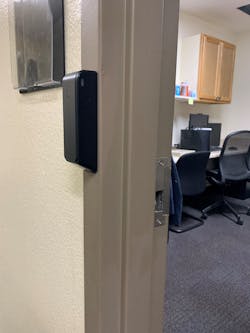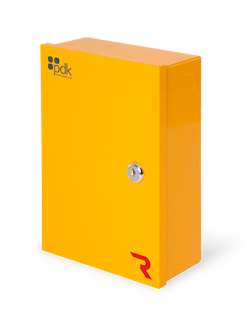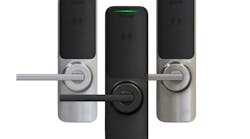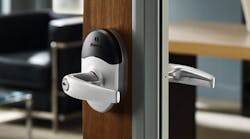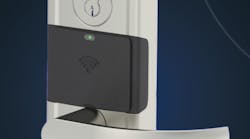A-1 Security Center and Advanced Lock and Security in Makvern, Pennsylvania, have been combined since Don Baker purchased A-1. The company now is called A-1 Advanced Lock & Security. Advanced performed more access control, and although Baker didn’t come from the industry, his son Jordan came to work for him and, being in his 20’s, he took naturally to the tech side of things.
We recently met up with Jordan Baker to discuss when and why to consider wireless technology.
Locksmith Ledger: When your dad bought the business, were you already involved in our industry?
Jordan Baker: He bought the business in 2019, and I was going to college at the University of Pittsburgh. I was working inside sales somewhere when he asked whether I wanted to come along. At the time, I knew nothing about this industry. The technology part came pretty easily. I took some computer-science classes in school, so that helped with things like programming and working with the software.
LL: What about the hardware-related part of locksmithing? How did that go?
Baker: I had no idea. It took a while, but I had good people around me to learn from. I learn best from hands-on experience instead of looking at videos or taking classes.
LL: So, you started out working in a shop doing everyday lock work?
Baker: Yes, so I have some experience with it. But our focus is on the access control side of things. Where we come together is when using wireless levers and electric strikes.
LL: When you started working in the field, was there a lot of running wire?
Baker: Actually, most of what we still do is running wire. That’s what I’ve learned and am still doing. I have been quoting some wireless product, but most of what we do is hard-wired. The lock guys still install a lot of the [Alarm Lock] Trilogys, etc. It’s difficult to sell people on the wireless access systems.
LL: When you began a few years ago, there probably weren’t as many wireless options as there are today. You didn’t give the wireless option much thought at all just three years ago, correct? What changed that has you even considering a wireless option now?
LL: So, the locks were powered by AA batteries with no wire to carry the data?
Baker: Data is transferred to a receiver wirelessly, which gets wired back to the access control panel. In this case, the troubleshooting was necessary because of a loss of connection or dead batteries, something that wouldn’t typically happen if it were hard-wired.
LL: Looking back, is there a way you could’ve avoided these problems?
Baker: With the options available, a lot of it could’ve been avoided. That version of the NDE locks isn’t being used anymore. It worked pretty well considering the options at the time. I feel as though you’ll always have to deal with these issues with wireless to some extent until the technology gets exponentially better.
LL: Under what circumstances do you see yourself recommending the wireless option?
Baker: Typically, we’d do so if there’s a long wire run. We recently quoted a system for an airplane hangar, and wireless seemed to be the best option, because there was a door within a large hangar door, and it would’ve been quite difficult to get wire to it. Or it might be an office building that has all hard ceiling, no drop ceiling. In my opinion, using wire mold in that type of environment just looks bad.
LL: Do systems typically give you the option of going wireless or wired? Or is it an either-or situation?
Baker: Some of the systems we work with will integrate with Aperio, by ASSA ABLOY. Aperio is a line of wireless levers that can be linked to an existing access control system. Again, data is transferred wirelessly, and the lock itself is powered by batteries. I even ran across an electric strike and reader that are wireless. The strike and reader are wired to each other. There’s no way of getting around having to power the product with batteries or having it wired. Wireless typically will refer to the transfer of data.
LL: Some in our industry avoid access control work because of the need to run lots of wire. What do you think?
Baker: The only time wire becomes an issue is if it’s all hard ceiling or all brick and concrete and your only choice is to run wire mold or conduit. That’s the time to consider a wireless option. Office [building managers] don’t care whether you run wire as long as they don’t see it.
LL: So, customers don’t care much about what you use as long as it looks good. Do many actually get involved in the technology, or do they simply want it to do what they want?
Baker: In some cases, it’s easier to install, and the technology is making it easier, but customers don’t care [about that] if it [doesn’t fit] within their budget. We just saw a demo of one [system] that’s all wireless and doesn’t require an internet connection; it’s a 4G-based system. The biggest reason customers decide against a wireless option is the price, particularly when you have to integrate with an existing system. They’ll charge a fee. Sometimes you’re changing what protocols the system uses to communicate with the devices. It’s a whole other portion of the code for the system.
LL: So, is it true that customers typically aren’t asking for a wireless system and that it’s more up to you as the security pro?
Baker: In some instances, it’s easier to just use wireless, but you have to convince them it’s worthwhile, because it’s typically going to be more expensive. Quoting eight doors wired is much different from quoting eight wireless levers.
LL: Are there times when the price of the more expensive wireless hardware is offset by the lower labor cost?
Baker: Customers will save money on less labor with wireless, but the bottom-line cost typically will be more with wireless because of the price of the product itself. When you hard-wire a system and then have to troubleshoot a problem, it’s much easier to resolve. Either there’s a bad connection or a problem with the device itself. With wireless, a whole bunch of things could be wrong.
LL: How different are things now than you might have pictured when you started several years ago? Has the progress been what you expected regarding the technology and product being used?
Baker: Regarding wireless locks, there are a lot more options. “Data on card” seems to be a technology that’s gaining popularity, particularly in the multifamily residential environment. These systems have hard-wired access doors at the perimeter of the building that send information to the card when it’s swiped. The unit doors themselves aren’t connected to the internet at all. They get updated with information whenever a card is swiped on them. If you were going to add a card into the system, you first would program the card into the software, swipe the card on the front door reader or whichever one is closest and then you would be able to use it on whatever unit it’s programmed to.
Something else I didn’t see being as popular as it is is the use of Bluetooth credentials. You can have your phone in your pocket and just touch the reader and the door opens. I didn’t see that coming so quickly.
LL: What do you see in the future? What’s being worked on and thought of that will be in place during the next 20 years or so?
Baker: I think the use of Bluetooth credentials will become standard, particularly because many companies offer them for free and cards are pretty expensive. I think wireless technology will continue to improve. It’s all about the communication method being used between the receiver and the device itself. You can send updates to the locks, for example, if a new feature comes out for them. Signal strength, reliability and price are most important. I can see wireless being used more as reliability improves and the price comes down. It’s just like Plasma TVs: They were expensive, and now you can get a flat-screen TV for $200.
LL: Any other obstacles you can think of that would help to explain why more locksmiths don’t transition to what you’re doing?
Baker: For locksmiths just getting into it, the biggest thing has to be the programming involved. The actual installation of the hardware is a piece of cake for most. That’s what they’ve been really good at. They’ll be much faster than I will installing wireless levers. Programming is what’s newer to many.
LL: Does size of the job matter when figuring out whether to offer a wireless solution?
Baker: As the buildings you’re working on get bigger with more space to cover, you have to add receivers, which require wire to be run. You still have to run some wire regardless. Until some sort of stand-alone lock that would be 4G- or 5G-connected [comes along], you’ll still have to have wire run to a panel of some sort.
An interesting thought: As more young people become involved in our industry, wireless solutions will be considered more often, but finding people who can install a wireless lever lock from a hardware perspective could be more difficult. Think about how difficult it is to find employees for your lock shop.
Steve Kaufman has worked for distributors in the locksmith industry since 1993 and worked as a full-time locksmith from 1978 through the 1980s. Kaufman is the sales manager for IDN Hardware out of its Philadelphia location.

